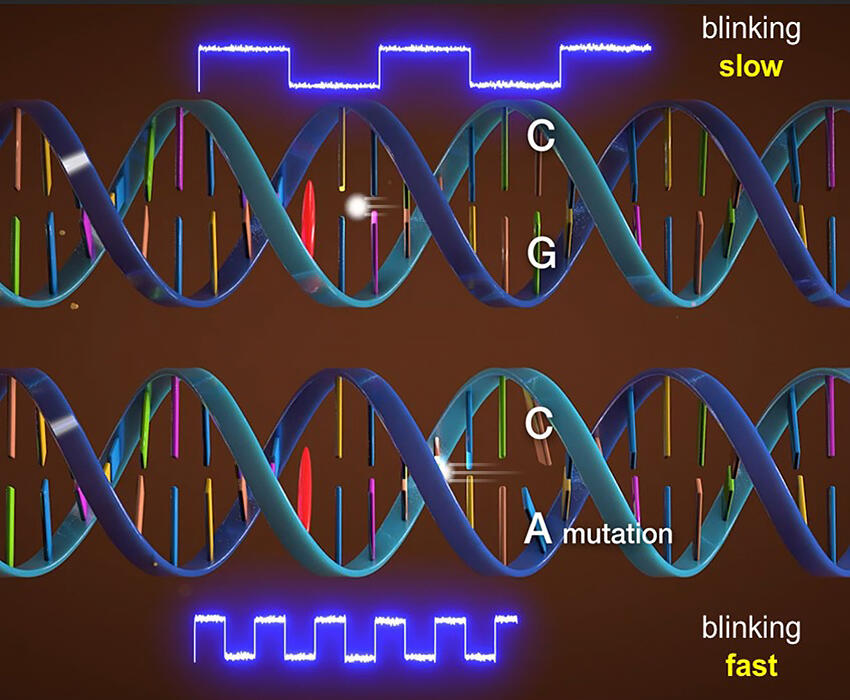A research group led by Associate Professor Kiyohiko Kawai, doctoral engineering student Shuya Fan and Professor Mamoru Fujitsuka of the Institute of Scientific and Industrial Research, Osaka University, in collaboration with Professor Kumi Kawai of the Department of Health and Nutrition, Shubun University, Professor Atsushi Maruyama of the Department of Life Science and Technology, Tokyo Institute of Technology, and Professor Atsushi Natsume of the Institutes of Innovation for Future Society, Nagoya University, has developed a method of measuring the speed of long-distance electron transfers in DNA with a single molecule, and successfully conducted in-situ diagnosis of single-molecule point mutations in mRNA on pathological specimens. "It currently takes three minutes to measure one point, but if we can expand this to two dimensions, we believe it can be used in rapid pathological diagnosis during surgery," explains Associate Professor Kawai. The group's findings were published online in Chem.

Provided by Osaka University
Associate Professor Kawai and his research group has used the phenomenon of blinking light emitted from a single molecule (fluorescence blinking) to measure a single molecule as the length of time that the chemical reaction disappears by fluorescence blinking.
In their research, they designed and synthesized a modified nucleic acid probe incorporating a fluorescent molecule and a hole acceptor. When bound to RNA in the cell, the charge moves along the DNA double helix, and point mutations alter the rate of movement by disrupting the structure. By using fluorescent blinking to measure the change as the blinking time, they could investigate whether a point mutation existed. "If we apply this to pathological sections, we can diagnose where the cancer cells come from and where they are located," explains Associate Professor Kawai.
Among brain tumors, adult glioma astrocytoma has an IDH (isocitrate dehydrogenase) gene mutation, and molecularly targeted drugs would improve treatment outcomes if they could be administered directly and at high concentrations. However, biopsies, in which a portion of an affected area is removed and examined before surgery, are difficult to undertake in the brain, and pathological diagnosis to diagnose cancer tissue after surgery requires another operation. This makes intraoperative rapid diagnosis of point mutations during surgery desirable.
In their research, Associate Professor Kawai and his colleagues, who are pathologists, attempted to detect point mutations in the IDH1 gene on pathological sections of tumor cells, and succeeded in a single-molecule diagnosis for the first time in the world.
This research is a collaboration between chemistry and medicine, but the impetus came from a conversation five years ago between Associate Professor Kawai and his sister, Professor Kumi Kawai, while at their parents' home on New Year's Day. "We were having trouble with the rapid diagnosis of cancer," explains Professor Kumi Kawai. The conversation started when she asked if there was any way to do this, and Associate Professor Kawai replied, "This method should be able to identify point mutations. And it can be done right away." The following week, she received the pathology sections, which made her keenly aware of the severity of pathological diagnosis. "The DNA probe we have created in this research can be used on other point mutations by changing the molecules incorporated in it," says Associate Professor Kawai. "We are currently developing a system to measure a wider area in a shorter time."
Journal Information
Publication: Chem
Title: Electron-transfer kinetics through nucleic acids untangled by single-molecular fluorescence blinking
DOI: 10.1016/j.chempr.2022.07.025.
This article has been translated by JST with permission from The Science News Ltd.(https://sci-news.co.jp/). Unauthorized reproduction of the article and photographs is prohibited.




